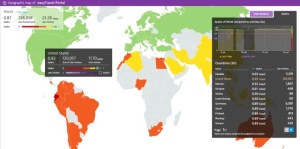With the recent news of Hewlett-Packard’s split into two companies, and struggling vendors like TIBCO Software going private to nurse their wounds, September’s news that application performance management (APM) leader Compuware was running both the split-apart and go-private gauntlets sent shock waves through the APM marketplace. The story this time, however, was not a vendor who had lost their way. On the contrary, Compuware’s split represents a shrewd move by a player focused on growth.
Compuware’s internal transformation, furthermore, is a harbinger of a broader shift in the APM space as digital transformation initiatives take hold at organizations around the world. As the broader technology landscape undergoes its own dramatic change, forcing businesses to double down on their customer focus, managing the performance of applications has never been more critical to the bottom line. As a result, the APM market is in the eye of the digital transformation hurricane.
Dynatrace Makes a Splash
 When private equity firm Thoma Bravo bought Compuware, they divided the newly private company into two parts: Compuware, focused on the traditional mainframe business, and Dynatrace, taking over the APM offerings. This dividing line neatly separates the high-margin, gradually declining value business that retains the Compuware name from Dynatrace’s position as the acquisition’s growth play.
When private equity firm Thoma Bravo bought Compuware, they divided the newly private company into two parts: Compuware, focused on the traditional mainframe business, and Dynatrace, taking over the APM offerings. This dividing line neatly separates the high-margin, gradually declining value business that retains the Compuware name from Dynatrace’s position as the acquisition’s growth play.
To be sure, growth is Dynatrace’s challenge as well as its opportunity. As the market leader over established APM players IBM, Dell , CA, and HP, as well as a large crop of smaller, fast-moving competitors, Dynatrace clearly has their work cut out for them. As John Van Siclen, General Manager of Dynatrace points out, “the digital world is different from the traditional world.”
However, Dynatrace isn’t satisfied to play a slow-moving market leader. Instead, they have created their own internal “startup,” ruxit, to drive innovation for the company as a whole. ruxit leverages artificial intelligence in smartscape, an analysis tool that automatically uncovers the root cause of performance issues in real-time, replacing the need for noisy alerts or busy dashboards that operations people must watch constantly. Furthermore, as Van Siclen says, “ruxit is targeted at cloud natives.” Time will tell whether ruxit’s innovation will help Dynatrace maintain its market leadership position.
Raising the Bar on APM
The digital world is where the growth in the APM market clearly lies, and yet, digital also raises the bar on APM. Managing web performance is vastly more complex than it was in the early days of the web, because today’s web sites – as well as modern mobile apps – typically include numerous third-party services.
“Most web pages and mobile apps these days are composed of multiple services – anywhere from dozens to hundreds,” explains Jyoti Bansal, Founder and CEO of Dynatrace competitor AppDynamics. “All of the moving parts may be working all right by themselves but there may be issues with how they interact with each other.” Online advertising, web statistics, and third-party logins using your Facebook or LinkedIn password are all examples of such third-party services that complicate the application management challenge.
Read the entire article at http://www.forbes.com/sites/jasonbloomberg/2014/10/10/the-rebirth-of-application-performance-management/.
Intellyx advises companies on their digital transformation initiatives and helps vendors communicate their agility stories. As of the time of writing, AppDynamics and AppNeta are Intellyx customers. All other companies mentioned are not. Dynatrace covered Jason Bloomberg’s expenses to attend their recent Perform Global User Conference, a standard industry practice. Image credit: ruxit.



